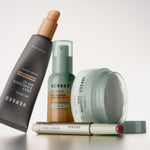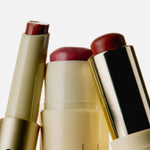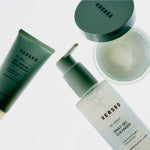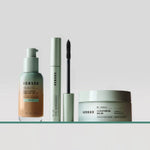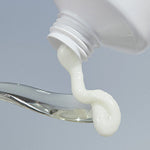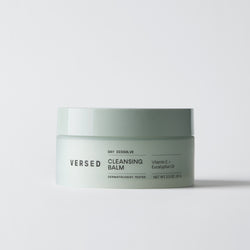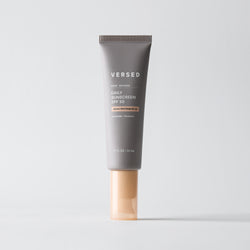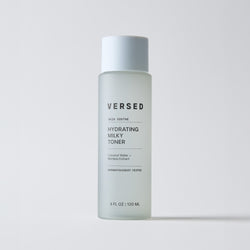From a scientific standpoint, the solution to clear skin is very simple. Clogged pores (bacteria + oil + dead skin cells) = acne. Add in some exfoliation and acne serums, subtract the DIY popping and makeup-caked brushes, and you should get nothing but blemish-free skin. Right?
When the math isn’t math-ing, you may be able to deduce that your acne is “probably hormonal.” But what exactly does that mean? How do you know whether your acne is truly hormonal or not? And most importantly: Is there a solution?
WHAT IS HORMONAL ACNE?
As you can probably assume, hormones are the catalyst for hormonal acne. “Typically, hormonal acne breakouts are brought on by elevated levels of androgen hormones or low levels of estrogen and progesterone,” says Dr. Michele Green.“Hormonal imbalances such as these can cause the sebaceous glands in the skin to produce excess sebum, which may then clog the pores and result in a breakout.”
While hormonal pimples are typically cystic, a deep and painful form of inflammatory acne, they can manifest as whiteheads and blackheads too, says Dr. Enrizza Factor. As long as the breakout can be attributed to a shift in hormones, it’s considered hormonal acne.
WHAT CAUSES HORMONAL ACNE?
So what causes hormone imbalances, exactly? A variety of factors. In adults, “hormone fluctuations happen mostly during menstruation cycles, pregnancy, and menopause,” Dr. Factor explains. PCOS, medications, and birth control are at play here too. Of course, hormonal acne is very common for all genders going through puberty as well. If you believe you have hormonal acne but none of these experiences apply to you, Dr. Green suggests consulting the experts. “For a definitive diagnosis, blood tests may need to be ordered to determine whether there are any systemic hormonal imbalances. Meeting with a dermatologist is always beneficial, as an expert can physically assess the skin condition and evaluate potential contributing factors, including medications, skincare products, behavioral factors such as sleep and stress, and any underlying health conditions.”HOW LONG DOES HORMONAL ACNE LAST?
A notable difference between hormonal acne and a typical breakout is the former can be somewhat predictable. “For many with hormonal acne, breakouts manifest in a cyclical pattern that aligns with their fluctuating hormones,” says Dr. Green. This is especially true for those with a monthly menstrual cycle, a common time for hormonal breakouts to debut. We recommend keeping a pouch of the Find Clarity Purifying Mask (and maybe some chocolate) handy when you know your cycle is approaching.
As far as how long hormonal acne lasts can depend on the type of pimples. Non-inflammatory acne, such as blackheads and whiteheads, typically goes away after a few days—especially if you suck the sebum and impurities out with an Acne Drying Treatment. If your hormonal acne is cystic, however, it can take a bit longer to heal—sometimes lasting several weeks.
CAN HORMONAL ACNE SHOW UP ON THE BODY?
Absolutely. In fact, Dr. Factor says that “one of the main causes of body acne is the change and fluctuation in hormone levels.” If you’re dealing with hormonal bacne, spritz on our Back-Up Plan Acne-Control Body Mist, which uses 2% salicylic acid and witch hazel to clear breakouts. Regular exfoliation using our AHA Exfoliating Body Scrub can help unblock clogged pores, too.
HOW TO TREAT HORMONAL ACNE
One of the most frustrating elements of hormonal acne is it’s often out of our control. You could be doing all the right things (washing your face before bed, using non-comedogenic formulas, exfoliating regularly) and still experience breakouts whenever your hormones fluctuate. Fun, right?
The upside is that hormonal acne, just like other breakouts, is treatable. Regularly cleanse the skin with a salicylic acid face wash, such as Keep the Peace Acne-Calming Cream Cleanser. Willow bark extract, found in our Clarifying Serum, also does wonders for oil control and reducing inflammation—especially helpful if you have sore, painful pimples.
More severe breakouts, such as hormonal cystic acne, may require a bit more help. Besides salicylic acid, Dr. Factor suggests incorporating retinoids into your routine. Our Gentle Retinol Serum pushes debris from the skin’s pores while simultaneously healing any acne marks left behind.
No matter what type of acne you have, if you’re not seeing results after a month or so, talk to your dermatologist about a treatment plan; they may prescribe medication for relief.
Shop the best products for hormonal acne (and all acne, for that matter) below.
